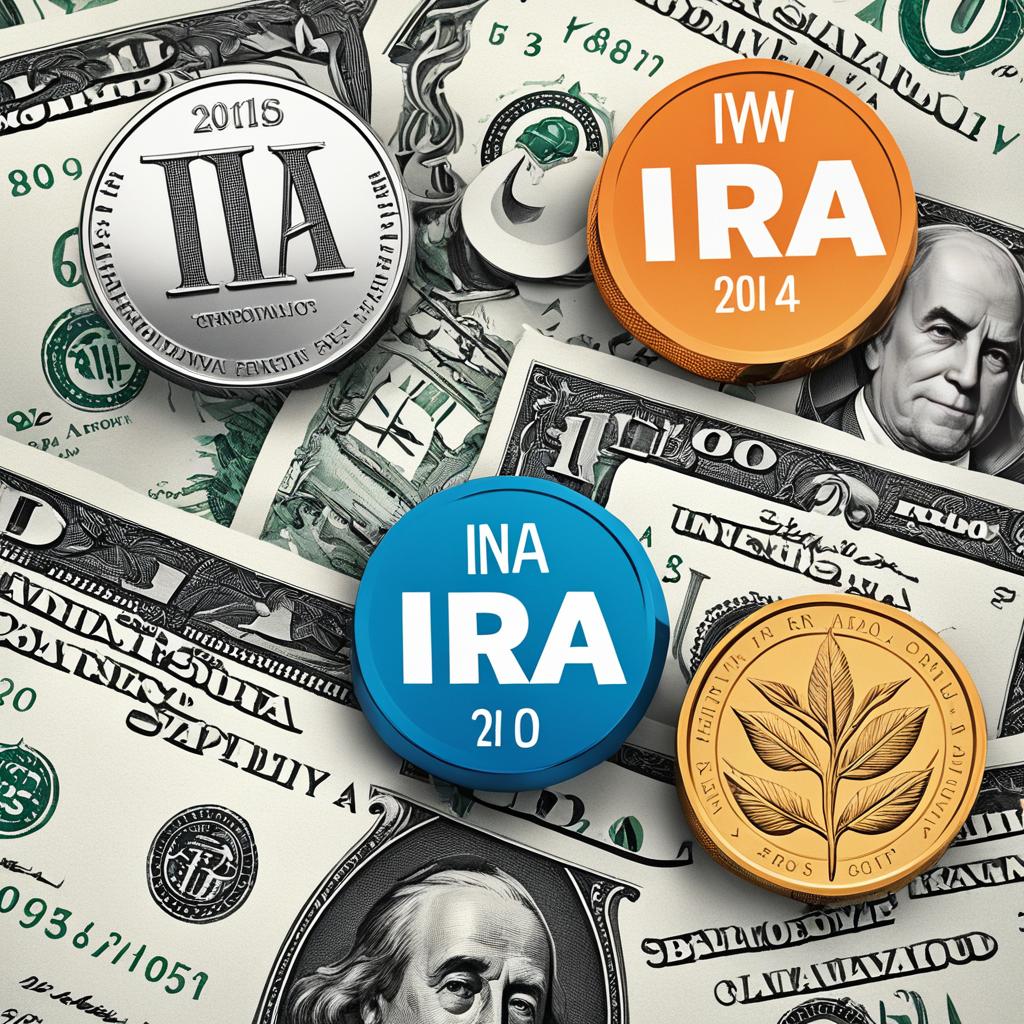Whether you are just starting out or midway into your career, understanding how to open an IRA and fund it will propel you onto the path to true retirement security. Anyone with earned income who meets the eligibility requirements can open an IRA. Money within the IRA account grows tax-free. We’ll take you step-by-step through the process of how to open an IRA account. You’ll discover how much it costs to open an IRA and how long it takes. Finally, you’ll learn where to open an IRA and whether to choose a Roth or traditional IRA account.
Key Takeaways:
- Opening an IRA is essential for long-term retirement planning.
- Anyone with earned income can open an IRA.
- IRA accounts offer tax-free growth.
- Consider whether a Roth or traditional IRA is best for your situation.
- Choose a reputable financial institution to open your IRA account.
Steps Required to Open an IRA
When it comes to opening an IRA account, there are a few important steps to follow. First, you need to decide which type of IRA is best for you. You have two main options: a self-directed IRA or a robo-advisor IRA. With a self-directed IRA, you have more control over your investments, while a robo-advisor IRA offers automated investment management.
Once you’ve determined the type of IRA you want, the next step is to choose the right financial firm to open your account with. Consider factors such as account fees, investment options, customer service, and reputation when making this decision.
Finally, you’ll need to decide whether a Roth or traditional IRA is the best fit for your financial goals. Roth IRAs offer tax-free withdrawals in retirement, while traditional IRAs allow for tax-deductible contributions.
Choosing Between a Self-Directed IRA and a Robo-Advisor IRA
When deciding between a self-directed IRA and a robo-advisor IRA, it’s important to consider your investment preferences and level of involvement. With a self-directed IRA, you have the freedom to choose and manage your own investments. This option is ideal for individuals who are knowledgeable about investing and want more control over their portfolio.
On the other hand, a robo-advisor IRA uses algorithmic technology to select and manage your investments for you. This automated approach is convenient for those who prefer a hands-off approach or may not have the time or expertise to actively manage their investments.
Choosing the Right Financial Firm for Your IRA
When selecting a financial firm to open your IRA account, it’s crucial to consider a few key factors. Look for a firm that offers low fees, a wide range of investment options, user-friendly technology, and excellent customer support. It’s also worth checking customer reviews and ratings to gauge the overall satisfaction of other account holders.
Deciding Between a Roth IRA and a Traditional IRA
The decision between a Roth IRA and a traditional IRA depends on various factors, including your current tax situation and future retirement goals. With a Roth IRA, you contribute after-tax dollars, meaning your withdrawals in retirement are tax-free. This option is appealing if you expect your tax rate to be higher in the future.
On the other hand, a traditional IRA allows you to contribute pre-tax dollars, reducing your taxable income in the year of contribution. However, withdrawals in retirement are subject to income tax. This type of IRA is advantageous if you anticipate being in a lower tax bracket during retirement.
| Roth IRA | Traditional IRA |
|---|---|
| Tax-free withdrawals in retirement | Tax-deductible contributions |
| After-tax contributions | Pre-tax contributions |
| More beneficial if you expect a higher tax rate in retirement | More beneficial if you expect a lower tax rate in retirement |
Choose between an Online Broker and a Robo-Advisor
When it comes to choosing an IRA provider, you have two primary options: an online broker or a robo-advisor. Each option offers unique benefits and considerations, depending on your investment preferences and goals.
Online Broker
If you want to have full control over your investment decisions and prefer a hands-on approach to managing your IRA, an online broker may be the right choice for you. With an online broker, you’ll have access to a wide range of investment options and tools, allowing you to research, select, and manage your investments independently.
Key advantages of choosing an online broker for your IRA include:
- Greater investment flexibility
- Direct control over your investment decisions
- Access to extensive research and analysis tools
However, it’s important to note that managing your investments through an online broker requires a certain level of knowledge and expertise. You’ll be responsible for conducting your own research, monitoring market trends, and making informed investment decisions.
Robo-Advisor
If you prefer a more automated approach to your IRA investments and want a digital platform to handle the investment decisions for you, a robo-advisor may be the ideal option. A robo-advisor utilizes advanced algorithms and technology to customize your investment portfolio based on your risk tolerance, goals, and preferences.
Some advantages of choosing a robo-advisor for your IRA include:
- Automated investment management
- Customized portfolio allocation
- Continuous portfolio monitoring and rebalancing
A robo-advisor eliminates the need for you to actively manage your investments, making it a convenient and time-saving option. It takes into account factors such as your age, income, and risk tolerance to create a diversified portfolio that aligns with your investment goals.
Ultimately, the choice between an online broker and a robo-advisor will depend on your personal preferences, investment knowledge, and comfort level. Consider your investment objectives, desired level of control, and willingness to actively manage your IRA before making a decision.
Now, let’s take a closer look at how to decide where to open an IRA and explore the factors to consider when selecting an IRA provider.
Comparison of Online Brokers and Robo-Advisors
| Factor | Online Broker | Robo-Advisor |
|---|---|---|
| Investment Control | Full control over investment decisions | Automated investment management |
| Investment Options | Wide range of investment choices | Customized portfolios |
| Research and Analysis Tools | Extensive tools and resources available | N/A |
| Portfolio Monitoring and Rebalancing | N/A | Continuous monitoring and automatic rebalancing |
| Expertise Required | Requires investment knowledge | No investment knowledge required |
Decide Where to Open an IRA
So, you’ve made the decision to open an IRA and start saving for your retirement. Now comes the next important step: choosing the right financial firm to open your IRA with. This decision can have a significant impact on your future financial well-being, so it’s essential to do your due diligence.
When deciding where to open an IRA, there are several factors to consider:
- Annual IRA management fees: One of the key factors to consider is the annual management fees charged by different financial firms. These fees can vary significantly, so make sure you understand how much you will be paying to maintain your IRA account.
- Investment minimums: Some financial firms may require a minimum initial investment to open an IRA account. Consider your budget and investment goals to determine if the minimum investment requirement is feasible for you.
- Available investments: Different financial firms offer varying investment options for your IRA. Research the types of investments available, such as stocks, bonds, mutual funds, or exchange-traded funds (ETFs), and ensure they align with your investment strategy.
- Customer service options: Accessibility to customer service is crucial when it comes to managing your IRA account. Look for firms that offer multiple channels of support, such as phone, email, and online chat, to address any questions or concerns you may have along the way.
- Customer reviews: Lastly, take the time to read customer reviews and ratings of different financial firms. This can provide valuable insights into the experiences of other IRA account holders and help you gauge the level of satisfaction and trustworthiness of each firm.
By carefully considering these factors, you can make an informed decision on where to open your IRA and ensure that you choose a provider that aligns with your financial goals and preferences.
Quote:
“Choosing the right IRA provider is a crucial step in securing your financial future. Take the time to research and compare different firms to find the one that best suits your needs and offers the right combination of investment options, fees, and customer service.” – John Smith, Financial Advisor
To help you get started, here is a comparison table of some popular IRA providers:
| Financial Firm | Annual Management Fees | Investment Options | Customer Service Options | Customer Reviews |
|---|---|---|---|---|
| Fidelity | $0 – $49.95 | Wide range | Phone, email, chat | 4.5 stars |
| Charles Schwab | $0 | Wide range | Phone, email, chat | 4.3 stars |
| Vanguard | $0 – $20 | Wide range | Phone, email, chat | 4.6 stars |
Keep in mind that this table is just a starting point, and it’s essential to conduct further research and compare the offerings of different financial firms before making a final decision.
Once you’ve identified the right IRA provider for your needs, you’ll be one step closer to achieving your retirement savings goals. It’s time to take action and start building your financial future.
Best IRA Accounts for Hands-On Investors
As a hands-on investor, you want access to a wide range of investment options and account types to maximize your opportunities. Fortunately, there are several top-tier IRA providers that cater specifically to your needs. Let’s take a look at three of the best IRA account options for hands-on investors:
| IRA Provider | Account Types | Investment Options | Fees | Customer Support |
|---|---|---|---|---|
| Fidelity | Traditional IRA Roth IRA Rollover IRA SEP IRA Simple IRA |
Stocks Bonds Mutual Funds Exchange-Traded Funds (ETFs) Options Derivatives |
Low trading fees No annual fees for IRA accounts |
24/7 phone support Online chat Branch locations |
| Charles Schwab | Traditional IRA Roth IRA Rollover IRA SEP IRA Simple IRA |
Stocks Bonds Mutual Funds Exchange-Traded Funds (ETFs) Options Derivatives |
Low trading fees No annual fees for IRA accounts |
24/7 phone support Online chat Branch locations |
| Merrill Edge | Traditional IRA Roth IRA Rollover IRA SEP IRA Simple IRA |
Stocks Bonds Mutual Funds Exchange-Traded Funds (ETFs) Options Derivatives |
Low trading fees No annual fees for IRA accounts |
24/7 phone support Online chat Branch locations |
These IRA providers offer a comprehensive selection of account types and investment options, allowing you to tailor your portfolio to your specific investment strategy. In addition to the wide range of choices, they also provide competitive fees and exceptional customer support, ensuring that you have the necessary resources to make informed investment decisions.
Whether you’re interested in stocks, bonds, mutual funds, ETFs, options, or derivatives, these IRA providers have you covered. With their user-friendly platforms and robust research tools, you can easily manage your investments and stay up-to-date with market trends.
Remember, choosing the right IRA provider is crucial when it comes to achieving your financial goals. Take the time to evaluate your investment needs and compare the features and benefits offered by different providers. By selecting one of these top IRA accounts for hands-on investors, you’ll be well-positioned to navigate the world of investing and grow your retirement savings.

Best IRA Accounts for Hands-Off Investors
If you prefer a hands-off approach to investing and want to let technology do the work for you, there are several excellent IRA account options available. These platforms offer automated investment management and low management fees, making it easier for you to grow your savings without actively managing your investments.
Here are some of the best IRA accounts for hands-off investors:
Wealthfront
Wealthfront is a leading robo-advisory platform that uses advanced algorithms to create and manage diversified investment portfolios. They offer a range of account types, including traditional and Roth IRAs, and provide personalized investment advice based on your financial goals and risk tolerance.
M1 Finance
M1 Finance is a unique hybrid platform that combines automated investing with customizable portfolios. With M1 Finance, you can choose from a selection of pre-built portfolios or create your own by selecting individual stocks and ETFs. They also offer IRA accounts with no management fees, making it an attractive option for hands-off investors.
Betterment
Betterment is one of the pioneers in the robo-advisory industry and offers a user-friendly platform for IRA investing. They use a sophisticated algorithm to determine the optimal asset allocation based on your financial goals, time horizon, and risk tolerance. Betterment also provides access to human advisors for more personalized guidance.
These IRA account providers are known for their simplicity, low fees, and ease of use, making them ideal for hands-off investors who prefer a set-it-and-forget-it approach to investing.
| IRA Provider | Features | Fees |
|---|---|---|
| Wealthfront | Automated investment management, personalized advice | 0.25% annual advisory fee |
| M1 Finance | Customizable portfolios, pre-built portfolios | No management fees |
| Betterment | Automated asset allocation, access to human advisors | 0.25% – 0.40% annual advisory fee |
With these IRA account options, you can enjoy the benefits of automated investment management while minimizing the time and effort required to oversee your portfolio. Consider your investment goals and preferences to choose the best IRA account provider that suits your needs.
Choose an IRA to Invest In
Now that you understand the basics of opening an IRA, it’s time to choose the type of IRA that best suits your tax and financial situation. There are two main types to consider: Roth IRAs and traditional IRAs. Each has its own eligibility limits, which depend on your income and whether you have a workplace retirement account.
“The best IRA for you will depend on your individual circumstances.”
If you expect to be in a higher tax bracket during retirement, a Roth IRA may be the right choice for you. Contributions to a Roth IRA are made with after-tax dollars, meaning you won’t owe any taxes on your withdrawals in retirement. It offers tax-free growth potential and flexibility in terms of withdrawals.
On the other hand, if you anticipate being in a lower tax bracket in retirement, a traditional IRA might be more suitable. Contributions to a traditional IRA are made with pre-tax dollars, reducing your taxable income in the year you make the contribution. However, you will owe taxes on your withdrawals in retirement.
To help you further compare and make an informed decision, here is a table summarizing the key features and contribution limits of both Roth and traditional IRAs:
| IRA Type | Contribution Limits | Tax Treatment | Withdrawal Rules |
|---|---|---|---|
| Roth IRA | $6,000 per year ($7,000 if age 50 or older) | Contributions with after-tax dollars Tax-free withdrawals in retirement |
Can withdraw contributions anytime Earnings can be withdrawn tax-free if certain conditions are met |
| Traditional IRA | $6,000 per year ($7,000 if age 50 or older) | Contributions with pre-tax dollars Taxed upon withdrawal in retirement |
Early withdrawals may incur penalties Must start taking required minimum distributions (RMDs) at age 72 |
Remember, choosing the right IRA is a personal decision that depends on your unique financial goals and circumstances. It’s always a good idea to consult with a financial advisor or tax professional to determine which IRA option is best for you.

Traditional IRA
A traditional IRA is one of the main types of individual retirement accounts available to investors. With a traditional IRA, you have the opportunity to contribute pre-tax dollars up to the contribution limit, which is set by the IRS each year. This means that the money you contribute to a traditional IRA is tax-deductible in the year that you make the contribution, providing potential tax savings.
One of the key benefits of a traditional IRA is that the money within the account grows tax-deferred. This means that you won’t have to pay taxes on any investment gains or dividends until you withdraw the money in retirement. This tax-deferred growth can help your retirement savings compound over time.
When you eventually start taking withdrawals from your traditional IRA in retirement, the money you withdraw will be subject to income tax. However, if you expect to be in a lower tax bracket during retirement, a traditional IRA can be advantageous because you’ll potentially pay less in taxes on your withdrawals compared to what you would have paid when you made the contributions.
It’s important to note that there are contribution limits for traditional IRAs, which can change from year to year. For the current contribution limits and eligibility requirements, refer to the IRS guidelines. Additionally, traditional IRAs have rules for required minimum distributions (RMDs) that must be taken starting at age 72, which is important to consider when planning your retirement income strategy.
Consider the table below for a quick comparison of the key features of a traditional IRA:
| Traditional IRA | |
|---|---|
| Tax Treatment | Tax-deductible contributions; tax-deferred growth; taxable withdrawals in retirement |
| Contribution Limits | For the current contribution limits, refer to the IRS guidelines |
| RMDs | Required minimum distributions starting at age 72 |
Ultimately, whether a traditional IRA is the right choice for you will depend on your individual financial circumstances and tax situation. It’s important to consult with a financial advisor or tax professional who can provide personalized guidance based on your specific needs and goals.
Roth IRA
A Roth IRA is a popular type of IRA account that offers unique tax advantages. Unlike a traditional IRA, contributions to a Roth IRA are made after-tax, meaning you don’t get an immediate tax deduction for your contributions. However, the main benefit of a Roth IRA comes into play when you start withdrawing funds in retirement.
Withdrawals from a Roth IRA are tax-free, as long as you meet certain requirements. This can provide a significant advantage if you expect to be in a higher tax bracket during retirement. By contributing after-tax dollars now, you essentially lock in today’s tax rates and avoid paying taxes on your withdrawals later.
There are several key features of a Roth IRA:
- Contributions: You can contribute up to the annual contribution limit set by the IRS. For 2024 and 2024, the contribution limit is $6,000, or $7,000 if you are age 50 or older.
- Tax-free withdrawals: Qualified withdrawals from a Roth IRA are completely tax-free. This includes both the contributions you made and any earnings on those contributions.
- No required minimum distributions (RMDs): Unlike a traditional IRA, a Roth IRA does not have any required minimum distributions. This means you can leave the funds in your account to grow tax-free for as long as you want.
- Income limits: There are income limits for contributing to a Roth IRA. For 2024, single filers must have a modified adjusted gross income (MAGI) less than $140,000, and married couples filing jointly must have a MAGI less than $208,000 to make the maximum contribution. However, even if you exceed these limits, there are methods available, such as a backdoor Roth IRA, to still contribute to a Roth IRA.
“A Roth IRA can be a powerful tool for retirement savings, especially if you expect your tax bracket to be higher in the future. By taking advantage of the tax-free withdrawals, you can potentially maximize your retirement income.”

When deciding between a Roth IRA and a traditional IRA, it’s important to consider your current and future tax situation. If you anticipate being in a higher tax bracket during retirement or if you prefer the tax-free withdrawal feature, a Roth IRA may be the better choice for you.
Now that you understand the benefits of a Roth IRA, let’s explore another type of IRA account known as a SEP IRA in the next section.
SEP IRA
As a self-employed individual, the SEP IRA is a type of IRA that provides you with an option for retirement savings. With a SEP IRA, employers can contribute up to 25% of the employee’s salary or $66,000 per year, whichever amount is less. This type of IRA shares many characteristics with traditional IRAs, offering tax advantages and potential growth opportunities for your retirement funds.
If you are self-employed or a small business owner, the SEP IRA may be the right choice for you. It allows you to contribute a significant percentage of your income, helping you build a substantial retirement nest egg. This makes it a valuable tool in your retirement planning strategy.
“The SEP IRA provides self-employed individuals and small business owners with a flexible and tax-advantaged way to save for retirement.”
When considering a SEP IRA, it’s important to understand the contribution limits. As I mentioned earlier, employers can contribute up to 25% of the employee’s salary or $66,000 per year, whichever is less. This can be a substantial amount, allowing you to maximize your retirement savings potential.
With a SEP IRA, you have the freedom to choose how much you contribute each year, depending on your financial situation. This flexibility can be especially beneficial for those with variable incomes or fluctuating revenue streams.
Remember, contributions to a SEP IRA are tax-deductible, meaning you can lower your taxable income by contributing to this type of retirement account. This can lead to significant tax savings, helping you keep more of your hard-earned money.
Let’s summarize the key points about the SEP IRA:
- Designed for self-employed individuals and small business owners
- Employers can contribute up to 25% of the employee’s salary or $66,000 per year
- Tax-deductible contributions
- Flexibility to contribute based on your financial situation
Now that you have a better understanding of the SEP IRA and its contribution limits, you can assess whether it aligns with your retirement goals and financial situation. Remember to consult with a financial advisor or tax professional to ensure you make informed decisions about your retirement savings.
Simple IRA
A Simple IRA is a retirement savings plan designed specifically for small businesses with 100 or fewer employees. It offers an attractive option for both employers and employees looking to contribute to their retirement funds.
In a Simple IRA, employers are required to make contributions on behalf of their employees. Employees also have the option to make elective contributions from their own salaries. This employer-employee contribution structure makes the Simple IRA a collaborative retirement savings solution.
Like other IRA account types, the Simple IRA has contribution limits and eligibility requirements. These limitations ensure that the plan is used as intended, benefiting small businesses and their employees.
| IRA Account Type | Contribution Limits | Eligibility Requirements |
|---|---|---|
| Simple IRA | Employee contributions: $13,500 (2024) Catch-up contributions (age 50 or older): $3,000 (2024) Employer contributions: Match up to 3% of employee’s salary or contribute 2% of the employee’s salary (regardless of whether the employee contributes or not) |
Employers must have 100 or fewer employees Employees must earn at least $5,000 in the previous year and expect to earn at least $5,000 in the current year |
By offering a Simple IRA, small businesses can provide a valuable retirement benefit while enjoying potential tax advantages. Employees can take advantage of the convenience and simplicity of the plan to save for their future. Overall, the Simple IRA is a flexible and accessible retirement savings option for small businesses and their employees.

Open an Account
Opening an IRA account is an essential step towards securing your financial future and retirement. To begin this process, you will need to provide personal and financial information to prove your identity and eligibility. Here is a step-by-step guide on how to open an IRA:
- Gather the required documentation: Before you start the account opening process, make sure you have the necessary documentation readily available. This may include your Social Security Number, government-issued identification, and employment information.
- Choose an IRA provider: Research and select an IRA provider that aligns with your investment goal and preferences. Consider factors such as fees, investment options, customer service, and reviews.
- Complete the application: Once you’ve chosen an IRA provider, you can begin the application process. This can typically be done online or in person, depending on the provider’s options.
- Provide personal and financial information: During the application process, you will be asked to provide personal and financial details, including your name, address, employment information, and financial account information for funding your IRA.
- Review and submit: Take the time to review your application thoroughly to ensure all information is accurate and complete. Once you’ve confirmed everything, submit your application.
- Fund your account: After your account is opened, it’s time to fund it. You can transfer funds from another retirement account, initiate a rollover, or set up regular contributions.
By following these steps, you’ll be on your way to opening an IRA account and setting yourself up for a more secure financial future. Take the time to choose the right provider and carefully consider your investment options. Remember, an IRA is a long-term investment, and regular contributions will help maximize your retirement savings.
Fund your account
Once you’ve successfully opened an IRA account, the next step is to fund it. There are several options available to you:
- Link an existing financial account: If you already have a bank or brokerage account, you can link it to your IRA and transfer funds directly. This is a convenient option if you want to allocate funds from your existing accounts towards your retirement savings.
- Transfer funds from a previous retirement account: If you have a retirement account with a previous employer, such as a 401(k) or 403(b), you can transfer the funds into your new IRA. This is known as an IRA rollover and allows you to consolidate your retirement savings into a single account.
- Rollover an existing IRA: If you already have an IRA with one custodian but would prefer to switch to a different one, you can perform an IRA rollover. This involves moving your IRA funds from one custodian to another. The process may vary depending on the financial institution, so it’s important to follow their specific instructions.
Regardless of which funding option you choose, it’s crucial to understand the specific rules and regulations surrounding each method. Consult with your financial institution or a qualified financial advisor to ensure you follow the correct procedures and avoid any potential penalties or tax implications.
Remember, funding your IRA is an essential step in building your retirement savings. By making regular contributions and taking advantage of potential tax advantages, you can set yourself up for a financially secure future.
Rolling Over an Existing Account
If you have an existing retirement account, such as a 401(k) or 403(b), you have the option to roll it over into an IRA. This can be a smart move if you want more control over your investments or if you’re looking for additional IRA benefits. There are two main options for rolling over your existing retirement account: a trustee-to-trustee rollover or a direct rollover.
- Trustee-to-Trustee Rollover: With a trustee-to-trustee rollover, you can transfer the funds directly from your current retirement account to an IRA without incurring any taxes or penalties. This is the safest and easiest way to roll over your retirement account, as the funds are never in your possession during the transfer.
- Direct Rollover: Alternatively, you can choose a direct rollover, where you receive the funds from your existing retirement account and then have 60 days to reinvest them into an IRA. However, it’s important to note that if you choose this option, 20% of the distribution will be withheld for taxes, and you’ll need to replace that amount when reinvesting the funds to avoid any tax penalties.
When deciding which rollover option is right for you, consider your comfort level with managing the transfer process and your ability to meet the 60-day reinvestment deadline. It’s also a good idea to consult with a financial advisor or tax professional to determine the best course of action based on your individual situation.
| Pros of a Trustee-to-Trustee Rollover | Cons of a Trustee-to-Trustee Rollover |
|---|---|
|
|
On the other hand, if you choose a direct rollover, it’s important to be aware of the potential tax implications and the need to replace any funds withheld for taxes within the 60-day period. If you fail to reinvest the full amount within the specified timeframe, you may be subject to taxes and penalties on the remaining funds.
Regardless of which option you choose, rolling over your existing retirement account into an IRA can offer several benefits, including greater investment flexibility, improved account management, and potential tax advantages. Take the time to thoroughly research and understand the rollover process, and consider seeking guidance from a financial professional to ensure you make the best decision for your financial future.
Funding From a Bank or Brokerage
If you’re looking to fund your IRA from a bank or brokerage account, there are a few simple steps you can follow to initiate the transfer or set up regular auto-transfers. Most financial institutions provide online transfer options through their dedicated transfer sections, making the process quick and convenient.
Here’s what you need to do:
- Log in to your bank or brokerage account.
- Navigate to the transfer section or tab.
- Select the option to transfer funds to an IRA.
- Choose the type of transfer you want to make. You may have the option to initiate a one-time transfer or set up automatic recurring transfers.
- Enter the necessary details, including the IRA account information such as account number and custodian name.
- Specify the amount you want to transfer.
- Review the details of the transfer to ensure accuracy.
- Authorize the transfer by confirming the transaction.
Once you’ve completed these steps, your bank or brokerage will process the transfer and deposit the funds into your IRA account. It’s important to note that different financial institutions may have their own specific procedures, so it’s advisable to refer to their guidelines or contact customer support if you have any questions or need assistance.
Remember, funding your IRA is a critical step in building your retirement savings. Regular contributions or automated transfers can help you consistently grow your investment over time.
“Consistent contributions to your IRA can have a significant impact on your retirement savings. Automating the process by setting up regular transfers from your bank or brokerage account can help you stay on track towards your financial goals.” – Financial Advisor
| Bank/Brokerage | Funding Options | Transfer Fees | Additional Notes |
|---|---|---|---|
| Bank of America | Online transfer, automatic transfers | $0 | – |
| J.P. Morgan Chase | Online transfer, automatic transfers | $0 | – |
| Fidelity | Online transfer, automatic transfers | $0 | – |
| Schwab | Online transfer, automatic transfers | $0 | – |
| Vanguard | Online transfer, automatic transfers | $0 | – |
Conclusion
Opening an IRA is a crucial step in securing your retirement and ensuring financial stability for the future. By following the step-by-step process of how to open an IRA account, you can embark on a journey of building your savings and making smart investment decisions to grow your wealth.
Choosing the right IRA provider is essential in setting yourself up for success. Consider your investment goals, risk tolerance, and the level of control you want over your investments. Whether you opt for a self-directed IRA or a robo-advisor managed IRA, make sure to research and compare different financial firms to find the one that aligns with your needs.
Once your IRA is open, remember that having an investment strategy is key. Regularly review and adjust your portfolio to keep it in line with your goals and market conditions. Stay informed about economic trends, new investment opportunities, and changes in tax laws that may impact your IRA. With a thoughtful approach, you can maximize the growth potential of your retirement savings.
FAQ
How do I open an IRA account?
To open an IRA account, you need to decide between a self-directed IRA or a robo-advisor IRA, choose the best financial firm for you, and determine whether to open a Roth or traditional IRA account.
How do I choose between an online broker and a robo-advisor?
You can choose to select your own investments with an online broker or opt for a robo-advisor that makes investment decisions for you based on your preferences.
How do I decide where to open an IRA?
When deciding where to open an IRA, you should consider factors such as annual management fees, investment minimums, available investments, customer service options, and customer reviews.
What are the best IRA accounts for hands-on investors?
Fidelity, Charles Schwab, and Merrill Edge are some of the best IRA account options for investors who prefer to have more control over their investments.
What are the best IRA accounts for hands-off investors?
Wealthfront, M1 Finance, and Betterment are some of the best IRA account options for investors who prefer automated investment management.
What types of IRAs can I choose from?
You can choose from traditional IRAs, Roth IRAs, SEP IRAs (for self-employed individuals), and Simple IRAs (for small businesses with 100 or fewer employees).
What is a traditional IRA?
A traditional IRA allows you to contribute pre-tax dollars up to the contribution limit, and the money is not taxed until withdrawal in retirement. It is best if you expect to be in a lower tax bracket in retirement.
What is a Roth IRA?
A Roth IRA allows you to contribute after-tax dollars up to the contribution limit, and withdrawals in retirement are tax-free. It is best if you expect to be in a higher tax bracket in retirement.
What is a SEP IRA?
A SEP IRA is a type of IRA for self-employed individuals. Employers can contribute up to 25% of the employee’s salary or ,000 per year, whichever is less.
What is a Simple IRA?
A Simple IRA is designed for small businesses with 100 or fewer employees. Employers are required to contribute to the account, and employees can elect to contribute as well. There are contribution limits and eligibility requirements.
How do I open an IRA account?
To open an IRA account, you need to gather the required documentation to prove your identity and provide personal and financial information. You can complete the account opening process either online or in person.
How do I fund my IRA account?
To fund your IRA account, you can link an existing financial account or transfer funds from a previous retirement account. You can also rollover an existing IRA from one custodian to another.
How do I roll over an existing retirement account into an IRA?
If you have an existing retirement account, such as a 401(k) or 403(b), you can roll it over into an IRA either through a trustee-to-trustee rollover or by withdrawing the funds and reinvesting them into an IRA within 60 days.
How do I fund my IRA account from a bank or brokerage account?
To fund your IRA account from a bank or brokerage account, you need to initiate a transfer or set up regular auto-transfers. This can be done online through your financial institution’s transfer section.
Our Friends
- https://www.investopedia.com/how-to-open-an-ira-7504812
- https://www.businessinsider.com/personal-finance/how-to-open-ira
- https://www.nerdwallet.com/article/investing/how-and-where-to-open-an-ira
Money posts:
 Roth vs. Traditional IRAs (2024)
Roth vs. Traditional IRAs (2024)
 SEP IRA Contribution Limits for 2024 and 2024
SEP IRA Contribution Limits for 2024 and 2024
 9 Best Investments for a Roth IRA (2024)
9 Best Investments for a Roth IRA (2024)
 12 Best IRA Accounts in 2024: Comparing Top Providers and Rates
12 Best IRA Accounts in 2024: Comparing Top Providers and Rates
 12 Best IRA Accounts in 2024: Comparing Top Providers and Rates
12 Best IRA Accounts in 2024: Comparing Top Providers and Rates
 Roth 401k Might Make You Richer (2024)
Roth 401k Might Make You Richer (2024)
 What are the 401(k) Contribution Limits for? (2024)
What are the 401(k) Contribution Limits for? (2024)
 Tips for Tax-Efficient Investing
Tips for Tax-Efficient Investing

